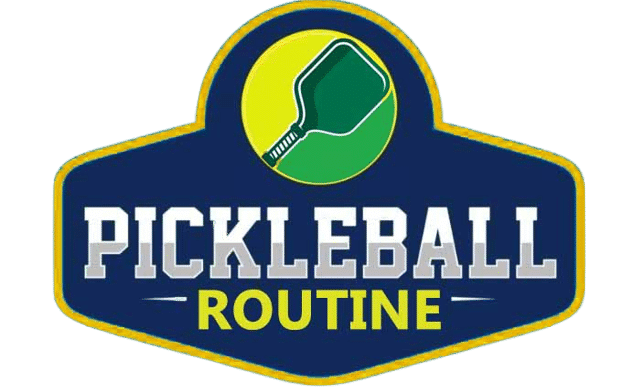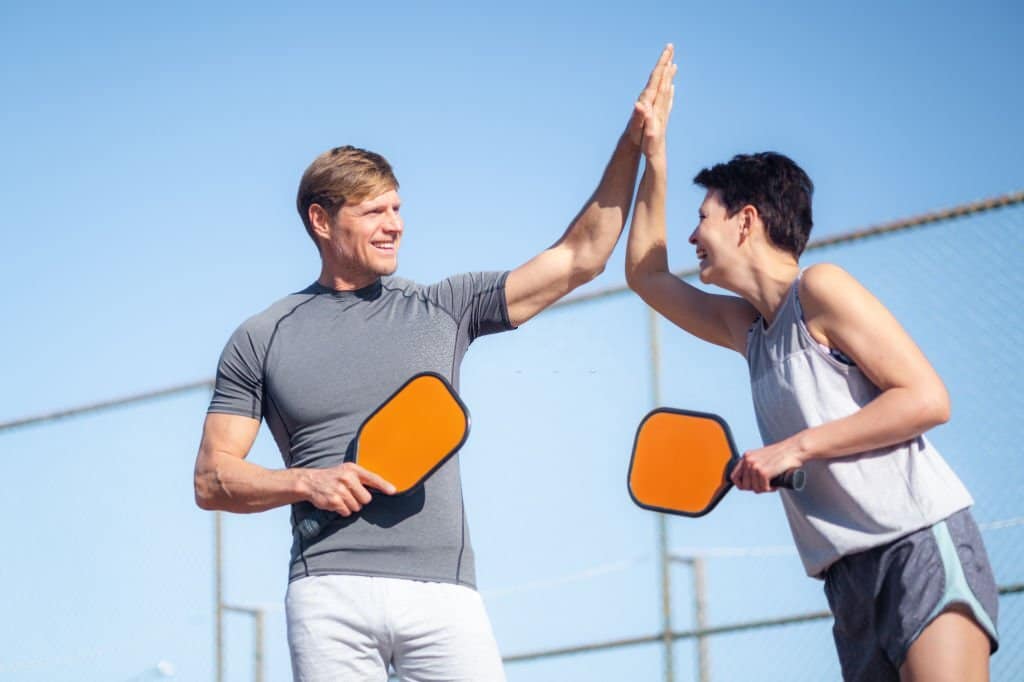Welcome to the exciting world of pickleball! If you are an intermediate player, you have already learned the basics of this popular sport.
Now, you are ready to improve your skills even more. In this article, we will discuss strategies that can improve your pickleball skills.
These tips will help you succeed on the court by improving shot selection, consistency, and overall performance.
Pickleball Drills for Intermediate Players:
Within the realm of pickleball, there exists an array of over 50 drills to select from.
However, do we really need to do all of these drills to become experts in pickleball? Certainly not!
Trying to do all of them might feel like too much, and it’s not possible to smoothly add them to the game.
To find the right pickleball drills for you, focus on the ones that match your skills and goals.
There are many options to choose from. Focusing on specific areas for improvement can lead to better results than doing many drills.
Now, let’s look at what experts suggest – important drills that really help in real games.
Precision Play: Mastering the Art of Shot Placement in Pickleball
Strategic shot placement plays a pivotal role in pickleball, exerting a substantial influence on your overall performance.
It’s crucial to master shot placement in pickleball, and here are a few fundamental pointers to bear in mind:
- Target areas where opponents struggle to respond effectively by exploiting open spaces.
- When playing, aim for lines or deep corners to disrupt your opponents’ rhythm and positioning.
- Use diagonal shots to complicate opponents’ access to the ball.
- Keep your opponents guessing by hitting shots to different areas of the court, such as the sidelines, middle, and corners.
- Direct shots to exploit opponents’ vulnerabilities and apply pressure.
- To place your shot well, you need to balance power and finesse and position the ball strategically. This helps you gain an advantage.
Improving your shot accuracy will give you more control over the game and increase your chances of winning in pickleball.
Third Shot Elegance: Enhancing Your Pickleball Arsenal with Soft Shots
For intermediate players, the third shot drop holds significant importance in pickleball strategy.
This technique helps you regain control and get a good position at the net. By moving opponents closer to the net, you have more time to get ready for your next shots.
This element is pivotal for skill enhancement and achieving victory. Emphasize mastery over the shot’s tempo and trajectory for optimal impact.
In pickleball, the third shot drop follows the serve and return of the serve. It entails a gentle shot that lands in the adversary’s non-volley zone.
The goal is to deter potent offensive returns and maintain command. Use finesse along with an upward swing and backspin to induce a rapid drop after the net.
Serving Excellence: Steps to Develop a Formidable Pickleball Delivery
The serve is an important shot that starts each point and can put your opponent on defense.
Several crucial aspects contribute to a potent pickleball serve:
- Lay the groundwork by understanding grip, stance, and bodily alignment.
- Develop a consistent toss to enhance ball contact and power.
- Use knee bending, weight shifting, and hip rotation for a forceful serve.
- Explore flat, topspin, and slice serves to introduce variety.
- Direct serves within the service box and is close to the baseline.
- To keep your opponent guessing, use a mix of wide, middle, and body serves.
- Stay patient, seek constructive feedback, and refine techniques for progress.
Dinks and Drops: Adding Versatility and Strategy to Your Pickleball Shots
A dink is when you gently place the ball near the net, making the opponent hit it upwards.
To make this shot, you need to hold the racket loosely, move your feet skillfully, and gently flick your wrist for accuracy.
The goal is to set the stage for an offensive opportunity. However, a drop shot is a gentle offensive move that makes the ball clear the net gracefully.
This maneuver aims to catch the opponent off guard and disrupt their rhythm.
To do this well, you need perfect timing, control, and a bit of trickery.
Both dinks and drop shots are important in pickleball strategy, especially in the non-volley zone.
The shots affect the game’s pace, create chances for aggressive shots, and put pressure on opponents.
To improve your skill in dinks and drop shots, practice them often. This will help you develop finesse, control, and precision.
The Power of Stacking: Using Court Placement to Keep Opponents Guessing
“Stacking” is a familiar tactic in the realm of pickleball. In doubles, players often stack on one side of the court to get a better position.
Sometimes, you may notice that opponents often target the weaker areas of certain players.
By adopting stacking and changing sides, opponents will find it challenging to target those weaker zones.
This not only keeps them on their toes but also introduces confusion into the game.
Effective Volley Techniques:
To become dominant at the net and gain an advantage in rallies, it’s important to master volleying.
Here are some effective pickleball volley techniques:
- Execute a small hop, landing with feet shoulder-width apart to prepare for quick reactions.
- Maintain balance with slightly bent knees, weight on the balls of your feet, and hold your paddle in front.
- Employ a relaxed grip, ensuring wrists and arms remain tension-free for improved control.
- Keep your gaze locked on the ball to enhance timing and accuracy.
- Keep your backswing compact to maximize control and swift responses.
- Utilize a punching or blocking motion to direct the ball back over the net.
- Position yourself close to the net for strategic shot choices and pressure on opponents.
- Practice volleys at varying angles to increase the challenge for your opponents.
- Implement small shuffle steps or split-step jumps for efficient movement.
- Anticipate your opponent’s shot and position yourself in advance to intercept the ball.
Strategies for Fast-Paced Games:
As an intermediate player, you will face opponents who prefer a swift pace.
To navigate such matches, consider these tips:
- Ensure precise footwork.
- Predict your opponent’s shots.
- Seize the initiative and adopt an aggressive approach.
- Incorporate dink shots to control the tempo.
- Prioritize consistency to minimize errors.
- Mix up your shots to unsettle opponents.
- Maintain effective communication with your partner.
- Remain mentally focused and composed.
Enhancing Gameplay through Anticipating Opponent Moves:
Mastering the skill of predicting and understanding your opponent’s shots can significantly alter the game’s outcome.
This ability is crucial for gaining an upper hand on the court.
Adopt the following guidance to enhance your proficiency:
- Watch how they position their body and hold the paddle to understand where they are aiming and what kind of shot they are going for.
- Analyze their shot selection patterns to anticipate their strategies.
- Pay attention to the ball’s speed, spin, and trajectory for more accurate anticipation.
- Factor in court positioning to foresee potential shot choices.
- Maintain focus, react swiftly, and remain prepared for any shot.
Defending and Counter-Attacking:
Defense is very important in pickleball. It requires accurate placement, anticipation, quick footwork, and control.
Skillful defense necessitates calculated positioning and controlled shots to counteract your opponent’s assault.
Counter-attacking means finding weak shots, placing the ball carefully and quickly, making smart shot decisions, and transitioning smoothly.
After a good defense, take the opportunity to counter-attack and regain control in the rally.
By refining these abilities, you can effortlessly overcome opponents, command the game, and attain triumph on the court.
Performing Under Pressure: Strategies for Staying Calm
In pickleball, staying calm under pressure is important for doing your best in competitive games.
To calm your thoughts, practice slow and steady breathing while maintaining relaxation.
Maintain a positive mindset and concentrate on the current moment.
See pressure as an opportunity and stick to your game plan. Also, practice mindfulness.
When dealing with intense court situations, stay focused and use effective strategies.
This will help you make smart choices and shoot accurately, giving you the advantage to win.
Mastering Adaptability: Elevating Your Pickleball Strategy
Strategic play entails tailoring your approach to unique court circumstances.
To exhibit intelligent play and adapt in pickleball, embrace these tactics:
- Analyze your opponent’s style and limitations.
- Choose shots cleverly, focusing on placement and diversity.
- Adapt your game strategy to capitalize on your opponent’s weaknesses.
- Anticipate and react swiftly to your opponent’s moves.
- Leverage your own strengths to secure an edge.
- Communicate effectively and collaborate with your doubles partner.
- Persistently refine your abilities and knowledge.
Stepping to Success: Enhancing Your Game with Effective Footwork
- Solid footwork is essential in pickleball to maintain stability, agility, and effective shot coverage.
- Consider these essential pointers:
- Keep your feet shoulder-width apart, knees flexed, and weight evenly distributed.
- Execute a small hop to regain balance and prepare for swift movement.
- Observe your opponent’s body position and racket orientation to predict shot direction.
- Take measured, controlled steps for stability and quick adjustments.
- Sidestep to efficiently cover the court area.
- Immediately return to the ready position after making a shot.
- Utilize pivots and rotations for positioning and shot power.
- Integrate footwork drills to enhance agility and coordination.
Crafting a Winning Team: Keys to Building a Strong Pickleball Partnership
Pickleball is a dynamic and fast-paced sport that demands exceptional coordination and teamwork.
Forming a robust partnership with your doubles teammate is paramount to achieving success on the court.
Consider these vital elements while forging a strong partnership in pickleball:
- Maintain transparent and open communication for swift joint decisions.
- Have faith in your partner’s skills and value their viewpoints.
- Be attentive to your partner’s position and movements to cover the court adeptly.
- Clearly define your roles and adapt according to your strengths in different scenarios.
- Regularly engage in team drills and refine your strategies together.
- Provide support and acknowledge each other’s accomplishments.
- Evaluate performances, pinpoint areas for enhancement, and continue learning.
Gear Up for Success: Optimizing Equipment in Pickleball
Just like any sport, having the right equipment can significantly elevate your performance on the court.
Let’s delve into how you can maximize your pickleball equipment to elevate your game.
- Take into account weight, grip size, and material. Lighter paddles offer agility, while heavier ones provide power.
- Choose a grip that offers both comfort and control. Experiment with various sizes and consider using over-grips or grip enhancers.
- Smooth surfaces offer control, while textured ones add spin. Choose according to your playing style.
- Choose indoor balls for their softness and outdoor balls for durability, based on the court conditions.
- Seek supportive and stable shoes with good traction for swift lateral movements.
- Wear comfortable clothes, use wristbands, headbands to soak up sweat, and carry a pickleball bag for organization.
Practice with a Plan: Elevating Your Pickleball Improvement Strategy
Engage in purposeful practice to optimize your advancement.
It’s not just about playing on the court. It’s about using your time well to improve.
- To enhance your pickleball skills effectively, follow these strategies:
- Define precise objectives for every practice session.
- Prioritize the quality of shots over their quantity.
- Tackle your weaknesses during practice sessions.
- Incorporate game-like scenarios into your drills.
- Seek input from others for valuable insights.
- Monitor your progress over time.
- Sustain a positive attitude throughout your practice.
Conclusion:
By integrating these pickleball drills into your practice routine as an intermediate player can greatly improve your performance.
These drills encompass various aspects such as accuracy, footwork, spin proficiency, and shot precision.
By dedicating time to these exercises, you will elevate your skills and become a more competitive player.
So, gather your equipment, partner up, and prepare to elevate your pickleball game to new heights.
Frequently Asked Questions (FAQs):
How can I enhance my shot placement in pickleball?
To improve your aim, focus on aiming for open spaces on the court instead of just using force. Aim for strategic shots that challenge your opponents’ positioning.
What does the term “third shot drop” mean in pickleball?
The third shot drop refers to a gentle shot played over the net following the serve. The purpose is to make opponents come closer to the net, so you have more time to position yourself for the next shot.
How can I develop a powerful serve in pickleball?
Practice different techniques, such as drive, lob, or spin, to improve your serve. Focus on consistency, precision, and altering the placement of your serves.
What do “dinks” and “drops” signify in pickleball?
Dinks and drops pertain to delicate shots that demand finesse and touch. Executed near the net, they prompt opponents to manage challenging shots.
Mastering these shots infuses your game with diversity and command.
How should I manage high-speed games in pickleball?
In fast games, stay calm, guess what your opponent will shoot, and focus on your form and technique.

It’s me Joe, a devoted pickleball enthusiast, and an avid player, I’m passionate about sharing the joy and excitement of the game through my Pickle Ball Routine. With years of experience on the court, I have honed my skills, explored various strategies, and developed a deep understanding of the nuances of pickleball.
I believe in the power of community and the incredible connections that can be forged through pickleball. I have had the privilege of engaging with players of all levels, from beginners seeking guidance to seasoned athletes looking to enhance their gameplay. My friendly and approachable demeanor makes me a valuable resource for players of all backgrounds.
Through Pickle Ball Routine, I aim to inspire and educate fellow pickleball enthusiasts. By sharing personal experiences, tips, techniques, and stories from the game, I strive to create a platform that fosters growth, camaraderie, and an unyielding passion for pickleball.

